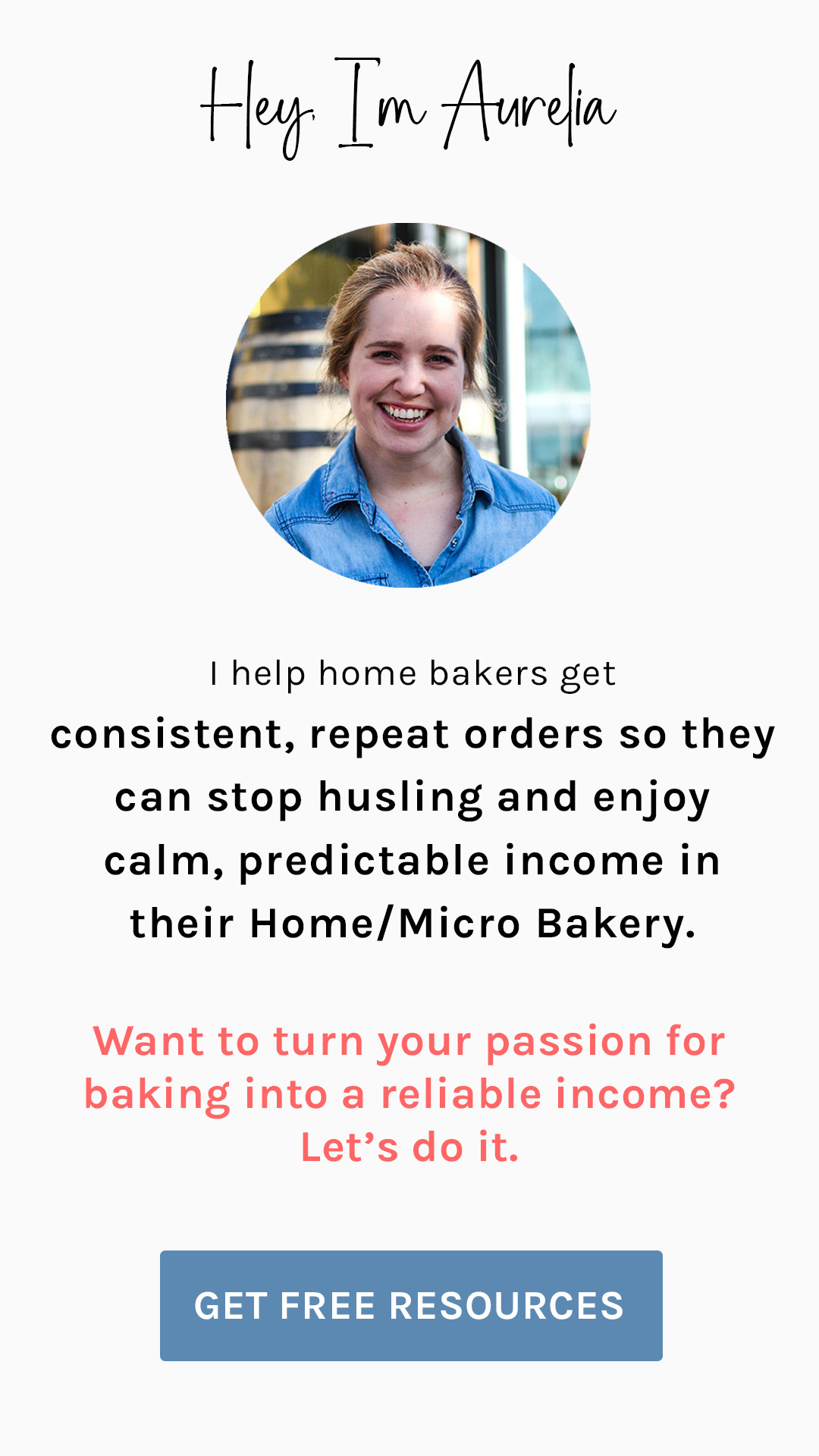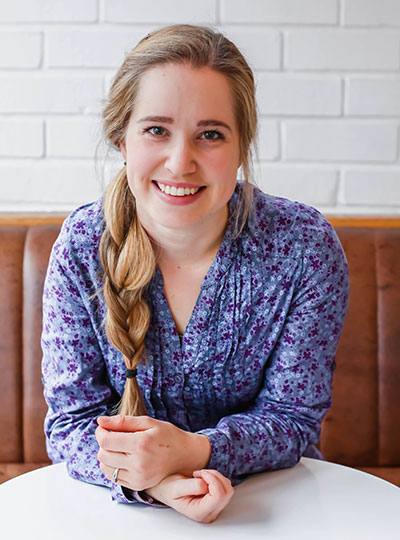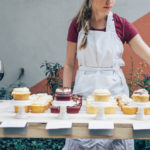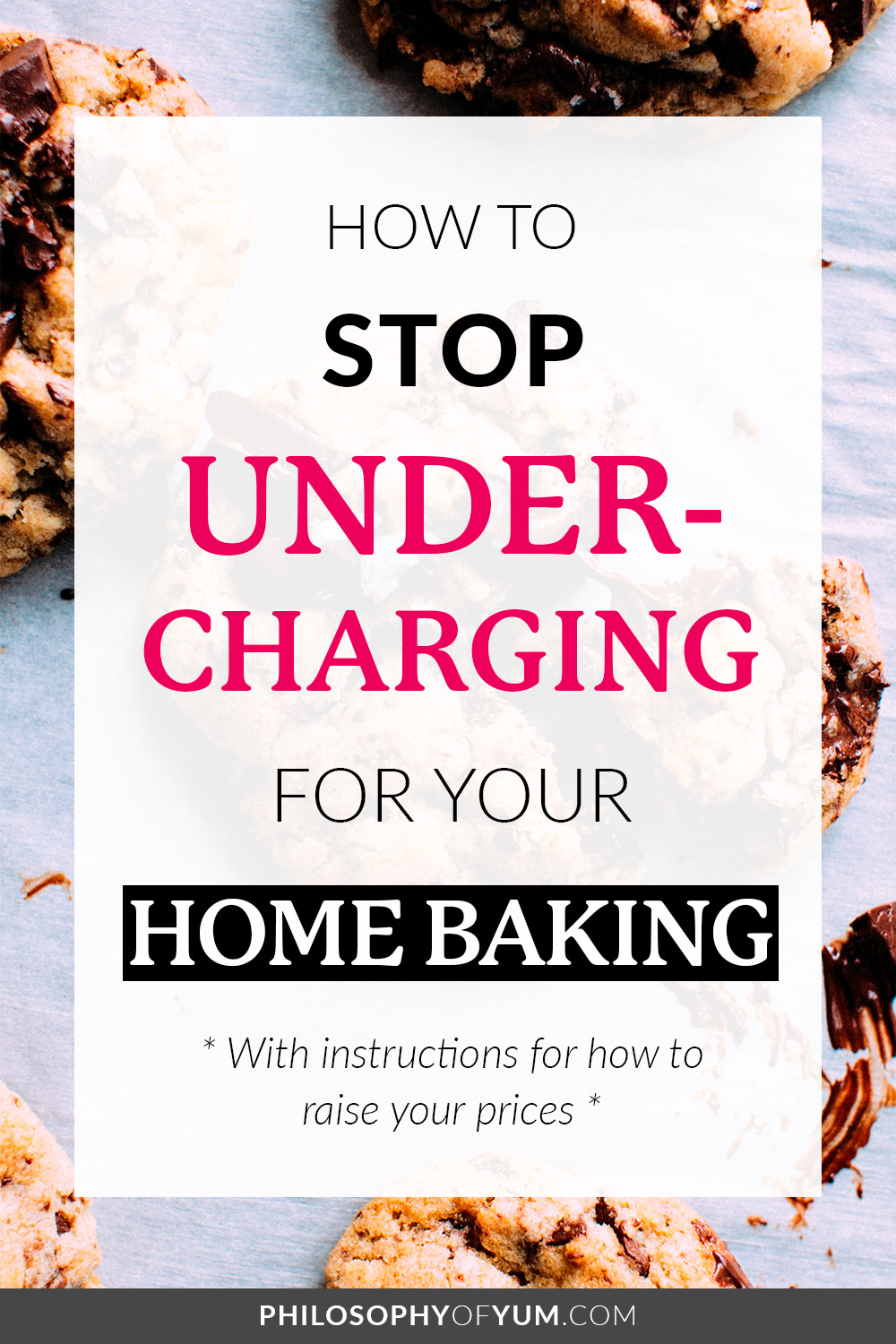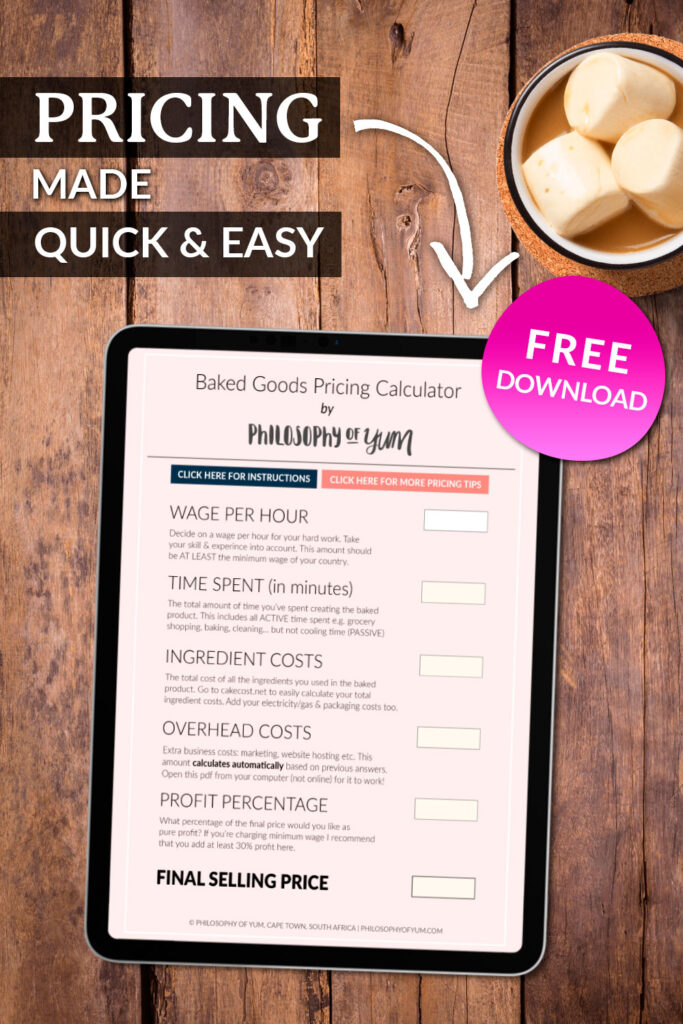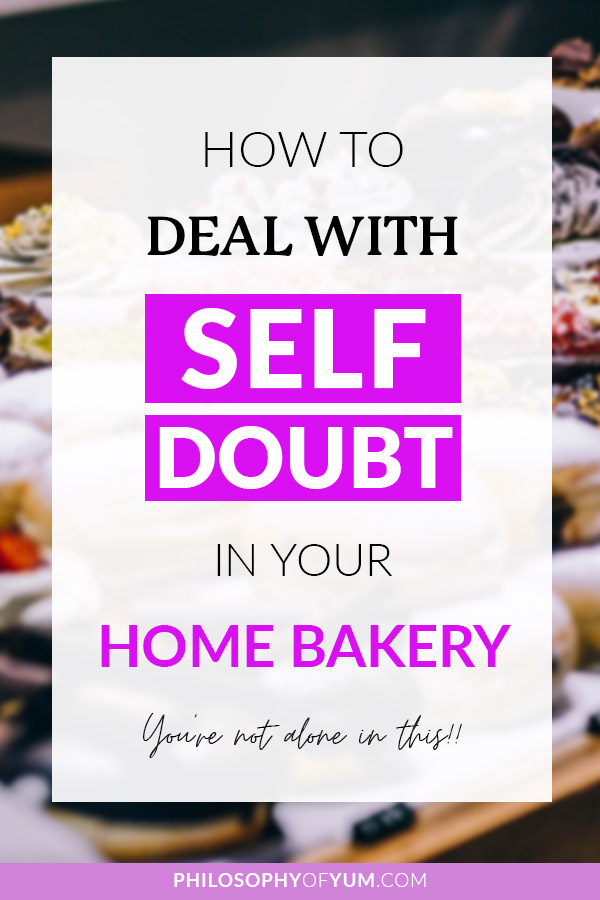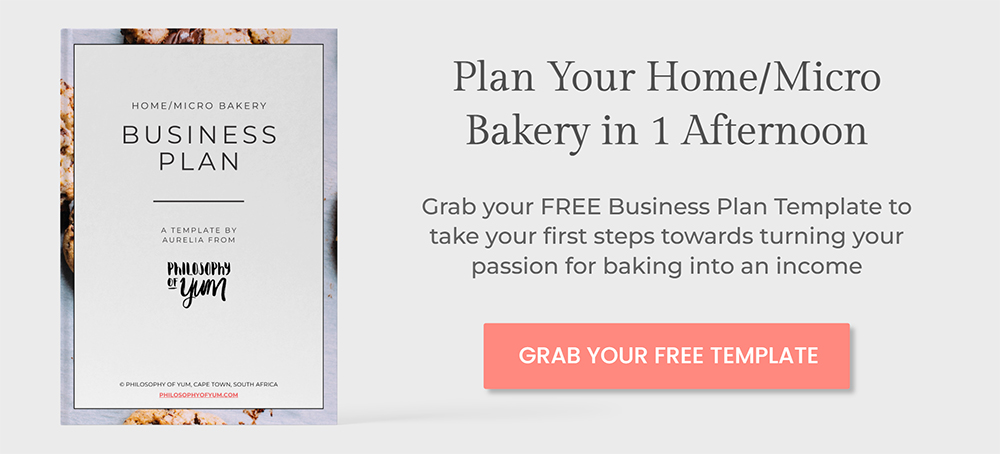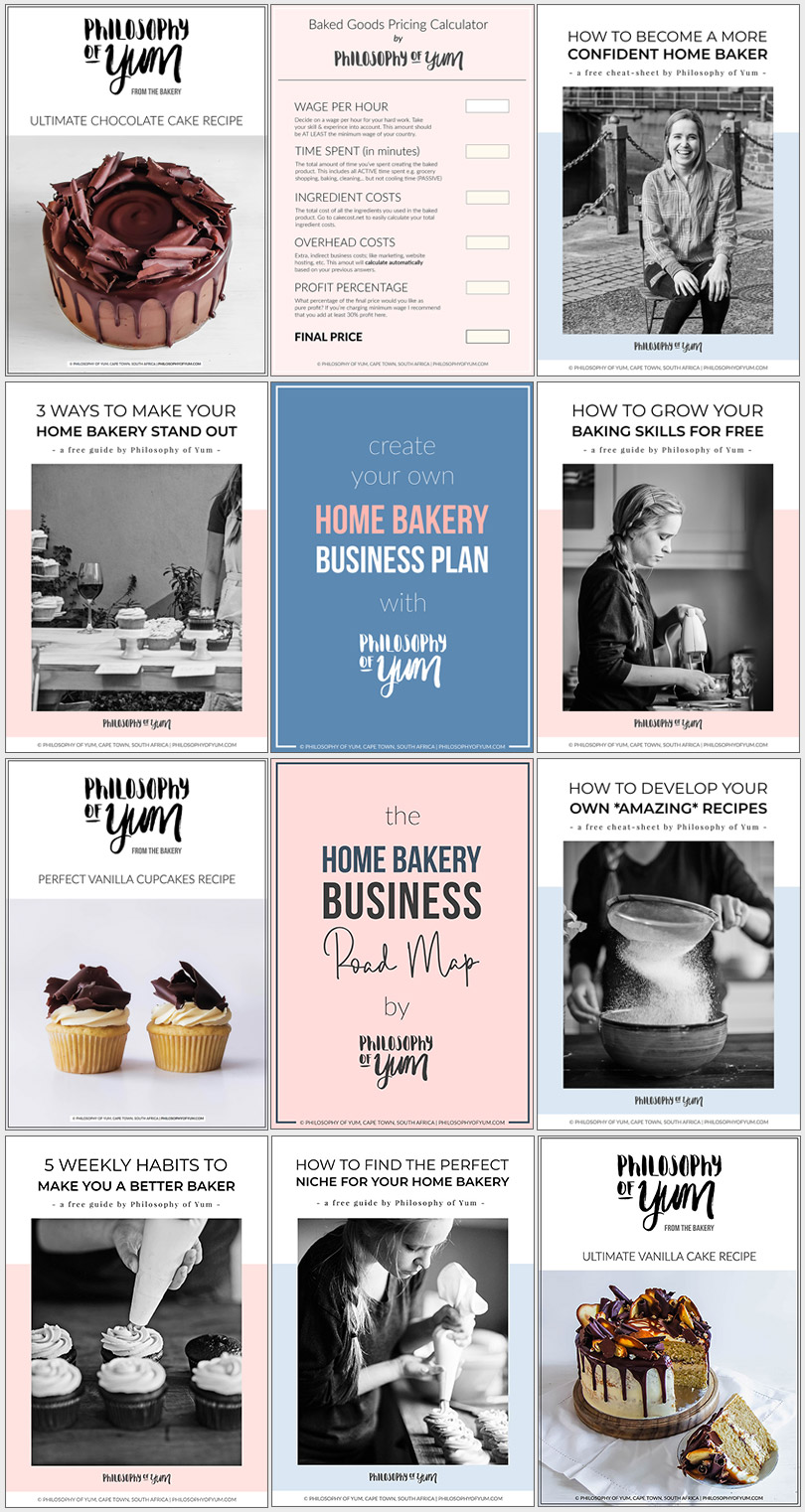How to Bake Perfect Cupcakes – Advanced Tips
Perfect Cupcakes are a science! In my previous post I covered all the basic errors that often occur when baking cupcakes.
Some of these errors include pointy cupcakes, overflowing cupcakes, shrinking cupcakes, etc. If you want to know the science behind these occurrences, click here.
I’m particularly excited for today’s post! It will be the first time I’m disclosing my top secret tips for baking EXCEPTIONALLY PERFECT cupcakes!
Error-free cupcakes are already a massive achievement, but over time I’ve discovered methods (some normal and some quite unorthodox) that have significantly improved the texture and quality of my cupcakes.
So with a cheerful and excited heart I am sharing this information with you 🙂 May there be myriads of perfect cupcakes baked across the world through these cupcake baking tips!
Please also share your thoughts below, if something is not making sense.
All Cupcakes are NOT Created Equal
There are obviously many posts on “How to Bake Perfect Cupcakes”. I will definitely share those tips as well. Some tips do apply to all cupcakes and are good methods to implement across the board.
I have found, however, that all cupcakes cannot be approached in the same way.
Butter based recipes respond completely differently to oil based recipes. If you want to bake perfect cupcakes, it is important to take note of this.

Through nearly 4 years of full time home baking, I’ve come to understand that cupcake recipes can be divided into 3 separate categories.
-
Butter based Recipes
-
Oil Based Recipes
-
Recipes containing fresh fruit/vegetables
These 3 recipe categories respond vastly differently to the environment in an oven. They cannot all simply be baked in “the center of the oven”.
My Baking Equipment
Although I am a full time baker, I do not do the industrial oven thing. I bake from home in my own itty-bitty kitchen because I LOVE being at home!
Most people are shocked when they see the size of my oven and kitchen, but I am really just so happy and content baking here 🙂
I tried working in an industrial kitchen… ONCE. We went through a lot of effort to move everything into the new kitchen. Everything was all set up and ready to go.
The huge convection oven was there waiting for me in the corner of the large kitchen… The idea of baking 6 pans of brownies all in one go was overwhelmingly exciting!
3 hours later I was in tears. My cupcakes were pointy. My brownies had no shiny crust. I had come to hate that convection oven in just 20 minutes! Singlehandedly, I loaded the car (I’m very little and weak), drove back home and started all over again with my orders for the next day.
I don’t have a fancy mixer. I have an old Kenwood standing mixer I got from my dear mother-in-law. The model is from the 80’s I think, but it works brilliantly!
- My oven is just a standard electric Defy Oven with a 4-plate stove on top (you will see a picture of it later).
- The previous flat we lived in had a standard built in electric oven.
- At one point we were living with my cousins, their oven was also just a standard electric oven.
- As a student I baked at my boyfriend’s house in their standard built in electric oven.
These methods for perfect cupcakes worked in all 4 of these ovens!
Gas ovens are a bit tricky though. You will find that you might not be able to apply some of these methods. Take what you can use and comment below if there’s a particular struggle you experience with cupcake baking.
RELATED: 14 Tools You Need to Start a Home Bakery
Methods that Apply to All
I’ve read through most articles online that cover the topic at hand. There are quite a few tips that appear on all of them.
Here’s a summary for Cupcake Baking Tips that do apply to all recipes (I’ve included my own as well). These tips do make a difference in the quality of your cupcakes.
1. Bring ingredients to Room Temperature:
This is a very important tip. Ingredients just combine better if they are all the same temperature.
Butter can take quite long to come to room temperature – especially in winter! I usually end up putting the butter in the microwave on the “defrost” setting for 15 seconds at a time if it is still not soft enough to cream.
Eggs should never be stored in the fridge in my opinion. Keep them away from direct sunlight, in a cool area. Buy smaller amounts of eggs at a time at more regular intervals. This ensures that your eggs will always be fresh and not need to be stored in the fridge.
If you do insist on keeping your eggs in the fridge, take them out the night before you plan to bake. This gives them ample time to come to room temperature.
Shortcut: put your eggs in a bowl of warm water for half an hour to bring them up to room temperature faster!
2. Use top quality ingredients:
What you put in, you will get out. Use free range eggs, real butter and good quality vanilla extract.

Image by nutritionsecrets.com
3. Don’t over-mix:
Some recipes require you to beat the batter for 2 minutes, others only until the ingredients are just combined. Just be sure to follow the instructions given in your recipe. Over-mixing directly damages the rise and texture of your cupcakes.
4. Oven Temperature:
Preheat your oven till the exact temperature before putting the cupcakes in the oven. Gas ovens tend to slip up on accuracy – hang an extra thermometer in your oven to be sure.
5. Consistent accuracy in filling cupcakes:
If you want to bake perfect cupcakes, you can’t just eye-ball when distributing the batter. Some insist that using an ice cream scoop full of batter in each liner will give you perfect cupcakes. This still leaves some room for error in my opinion.
It might be overkill, but weigh the batter you put in each case till your eyes can tell the difference. If it’s a more liquid batter, you can use a measuring cup as well.
Do yourself a favour and invest in a digital scale! They are affordable and so convenient! I have a small A5 size scale.
You can place your entire cupcake pan on top of the scale, “zero” it, and weigh each amount of batter that goes directly into each liner.
 Images by bhg.com and rachelteodoro.com[/caption]
Images by bhg.com and rachelteodoro.com[/caption]
Here’s what I do:
- I make sure to remember the weight of my mixing bowl (or write it down).
- Then I weigh the mixing bowl with the batter.
- Subtract the weight of the bowl plus an extra 5 g for the batter that sticks to the bowl and spoons.
- Divide that amount by the amount of cupcakes your recipe makes.
- Place the lined cupcake tin on the scale and weigh the batter out cup for cup.
- Bit of a mission, but it gives me perfect cupcakes, so it’s actually a small sacrifice!
6. Proper greasing:
Even though I use cupcake liners, I also grease the top rim of each cupcake hole in the tin. This makes it easier to loosen the edges of the cupcake that did come into contact with the pan.
7. Don’t over-bake:
Don’t go shower and wash your hair while you are baking cupcakes! Give a peek through the glass every now and then to check on them. Once you can see there is no more shiny batter in the centre of each cupcake, wait for another minute and then test them.
You do want the testing pin to be clean, but do be careful not to leave the cupcakes in there for too long.
8. Turn or Burn?:
I do turn my cupcakes halfway through baking. Always. The odds of them deflating through doing this are really small. Obviously you shouldn’t do this with a soufflé! With cupcakes I think it is essential for an even bake.
All domestic ovens I have baked in tend to be hotter in the back left corner for some reason, so I insist on turning the cupcakes.
Rotate your cupcake pan with care. If you handle the pans gently, they will be just fine. Don’t bang it down on the counter; treat the pan like a sleeping infant.
9. Accurate measuring and weighing:
Weigh anything that is not liquid! This is my motto. I weigh my baking powder and baking soda while sifting the dry ingredients together.
Seriously 1 little gram does make a difference! Think about how dangerous measuring is. Some folks scoop out a compacted teaspoon of baking powder, while others pour it out of a refill pack. There is just too much room for error.
Write down on each recipe the exact weight of baking powder you use so that you will know for the next time you make that recipe and get consistent results. Also stick to one brand! All of them differ, even if it is just slightly.
I always WEIGH the amount of egg I use. Crack it in a cup, whisk it lightly with a fork and then weigh the exact amount of grams you put in.
If the cupcakes come out perfect, make a note on your recipe of the weight of egg you used, so that you’ll know how much to use when you make the recipe again.
If you feel the cake needed a bit more egg, make a note of that too. Weighing the amount of egg I use has made all the difference in my baking.
10. Fill, but don’t spill:
This may seem obvious, but I’m mentioning it anyway. Be patient when filling your cupcake liners with batter.
Rather scoop smaller amounts at a time (right into the center of each liner) to avoid spilling. Batter can easily end up between the liner and the tin. This will result in messy edges on your cupcakes! It can even let your cupcakes rise lopsided.

Advanced Tips for Baking Perfect Cupcakes:
As mentioned before, I have come to see that cupcake recipes can be divided into 3 separate categories.
1. Butter based Recipes
2. Oil based Recipes
3. Recipes containing fresh fruit/vegetables
These 3 recipe categories respond vastly differently to the environment in an oven. I will discuss each category separately.
Most importantly: I do not agree that all cupcakes should be baked in the center of your oven. In fact, I do not think ANY cupcakes besides Vanilla Cupcakes should be baked in the center of your oven.
Step one is to divide your oven cavity into 3 equal parts using 2 oven racks, like this.
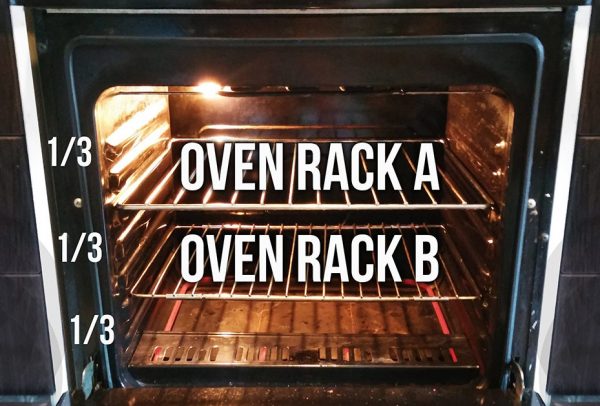
Let’s number the upper oven rack as Oven Rack A and the lower one as Oven Rack B. This is the basis of everything I do. You will understand why a bit later. This arrangement is THE FRAME WITHIN WHICH ALL MY METHODS ARE APPLIED.
1. Butter Based Recipes:
I do prefer the creaming method, but I find that standing mixers incorporate a bit too much air. Light cupcakes are fantastic, but if they are too light, they are very difficult to handle and little edges often end up breaking off.
For this reason I prefer to use a hand-held electric whisk. When baking large cakes, a standing mixer is perfect for mixing a butter based batter.
Mixing Batter & Filling Cases:
Add dry ingredients to bowl as instructed. Beat on low speed for 10 seconds to get most of the ingredients combined. Stop the hand mixer.
Take care to scrape around the sides and bottom of the bowl with a rubber spatula to make sure all the butter gets incorporated into the batter. Resume beating on medium speed for a further max 10-12 seconds.
Remember, little lumps are not evil! They will disappear during baking. Your batter does not have to be smooth!
Obviously there shouldn’t be large lumps of flour. Squash a few of the lumps out with a spoon to check if they are solid dry flour or a harmless bit of batter that just appears lumpy.
After dividing the batter into the lined tin (aluminum preferably!), it is important to smooth out the batter before baking.
Smooth out the surface of the batter in each hole with a teaspoon. Push the batter up slightly against the edges of the wrapper. I find this helps the cupcakes get an even start in their rising process once in the oven.

Baking:
- Butter based Cupcakes bake best on Oven Rack A (or in the center of your oven) at 180˚C.
- The cupcakes deeper in the oven will rise faster than those in front. About 8 minutes in, you will need to rotate the cupcakes 180 degrees. Do not take the cupcakes out of the oven to do this. Gently rotate the pan in the oven.
- Once you can see there is no more shiny batter in the center of each cupcake, wait for another minute and then test them. You do want the testing pin to be clean. Butter based cupcakes tend to sink if they are under-baked.
- When they are done baking, there might be slight variations in size. To fix this is super easy, but it has to be done immediately when the cupcakes exit the oven. You only have a 1 minute window to do this before the cupcakes start firming up. Wipe a butter knife on some butter so it has a very light coating of butter to prevent the cupcake from sticking to the knife. Gently push in edges of the cupcakes that are not perfect according to your liking. Tada! Perfect Cupcakes!

- Allow them to cool for about 7 minutes in the tin before transferring them to a rack to cool further.
2. Oil based recipes:
This is where it gets weird. When I started baking more seriously in 2012, I still baked 2 trays of cupcakes at the same time. This saves time and electricity of course!
When it came to the Red Velvet Cupcakes, the cupcakes from Oven Rack A turned out vastly different from Oven Rack B.
The cupcakes from Rack B were so beautifully smooth on top and had a very slight dome – perfect cupcakes! The cupcakes on rack A were a bit cracked, did not rise as well as the cupcakes on rack B, and were a little too pointy.
I realized that this phenomenon couldn’t have anything to do with the batter as the same batter was used for both cupcake trays. The secret HAD to be in the baking.
Baking:
Over time I developed this technique:
Even though your recipe may say “Bake in the center of your oven at 180˚C”, don’t do it. Try this baking method for your oil-based recipes like Red Velvet and Chocolate.
- Preheat your oven to 170˚C.
- Place a clean and empty roasting tray on rack A.
- Place your cupcakes on rack B.
- Pour about 1/2 cup water (boiling or not, doesn’t matter) in the bottom of the oven. Truthfully, I cannot even remember how I ended up doing this in the first place, but it really helps the cupcakes rise so much better and keeps them super moist! (DON’T TRY THIS with BUTTER BASED RECIPES. The cupcakes end up overflowing and come out too soft and fragile.)
- Turn halfway through baking.
- They are usually done baking when there is no shininess left in the center of the cupcakes – which you can see through the glass door.
- Remove from the oven and leave to cool in tins for about 7 mins, then transfer to a cooling rack.
- Once again, if there is an edge that didn’t come out perfectly round, don’t panic! You can push it in slightly, while the cupcakes are still hot and slightly malleable, with a butter-wiped-knife. Tada! Perfect Cupcakes!
- Another handy tip (applies to Fresh Fruit/Vegetable Recipes as well): Just before you pop your cupcakes in the oven, drag the batter right up the sides of the liner all the way around. This not only gives your liner an even appearance on the outside, but also helps your cupcakes to rise evenly. Don’t do this too early or the batter on the sides will dry out and actually cause your cupcakes to rise poorly.
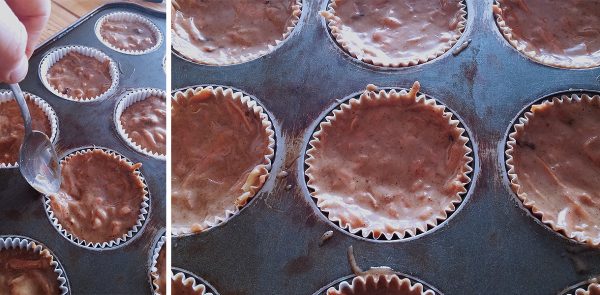
3. Recipes containing fresh fruit/vegetables:
This includes recipes like Carrot Cake, Zucchini Chocolate Cake and German Apple Cake. You probably know that these recipes end up releasing a lot more moisture during baking. The fresh fruit/vegetables release liquid as they bake.
Mixing Batter & Filling Cases:
The biggest tip for making perfect cupcakes from these batters is in the dividing of the batter between your cupcake cases – for 2 reasons:
1. These recipes contain lots of bits. Carrot Cake, for example, can contain grated carrot, raisins, nuts and crushed pineapple! If you fill your cupcakes fully from cupcake 1 down to cupcake 12, the last cupcake often ends up with 1 nut, 1 raisin and a whole lot of batter. The rise is also drastically affected. The last cupcake will rise beautifully, or even too much, while poor cupcake number 1 is an under risen lump of carrot and raisins.
2. Sugar and salt draw out liquid from fresh fruit & vegetables. The longer your batter stands, the more liquid it will become. If you fill your cupcakes fully from cupcake 1 down to cupcake 12, the last cupcake will get batter with a higher liquid content compared to cupcake 1.
To solve these problems, fill all your cupcakes halfway first, from cupcake 1 to cupcake 12. Make sure each one gets a helping of all the bits in the batter.
At this point it is important to give your batter a fold or two, just to distribute the additional fruit/vegetable liquid that has been released.
Then distribute the batter again, going from cupcake 12 to cupcake 1. This method gives me the most consistently perfect cupcakes.
Another handy tip: Just before you pop your cupcakes in the oven, drag the batter right up the sides of the liner all the way around. This not only gives your liner an even appearance on the outside, but also helps your cupcakes to rise evenly.
Don’t do this too early or the batter on the sides will dry out and actually cause your cupcakes to rise poorly. *See image above for this tip.
Baking:
- I find Oven Rack A at 180˚C to be best for baking these recipes. No rocket science in the baking here.
- Turn halfway through baking.
- They are usually done baking when they have an even colour on top. If the center of the cupcake is lighter in colour, they are probably not done yet.
- When done, remove from the oven and leave to cool in tins for about 7 mins, then transfer to a cooling rack.
- Once again, if there is an edge that didn’t come out perfectly round, don’t panic! You can push it in slightly, while the cupcakes are still hot and slightly malleable, with a butter-wiped-knife.

A shout out to all these lovely posts on how to bake perfect cupcakes! These were the most helpful and accurate ones 🙂
“Cupcakes 101: 10 Tips to bake the perfect cupcake” (This is my favourite one), “5 Steps to Perfect Cupcakes”, “10 Tips for making Perfect Cupcakes”, “How to Make Perfect Cupcakes”, “Top tips for Baking Better Cupcakes”, “10 Tips for Baking a Perfect Cupcake”
Gosh, this post was quite intense!! I need a drink… dark hot chocolate… Made with cream… With a cinnamon doughnut on the side… yes please!
I really hope you find this helpful. These tips have transformed the quality of my cupcakes forever. I trust they’ll do the same for you!
Want Perfect Cupcake Recipes?
Today’s your lucky day because I’m giving you my Home Bakery’s 3 most popular, perfected Cupcake Recipes for FREE! I’ve spent 7 years perfecting these recipes and have baked and sold literally THOUSANDS of these cupcakes.
- Perfect Vanilla Cupcakes Recipe – join the free Resource Library for Home Bakers to get the recipe.
- Ultimate Carrot Cupcakes Recipe – click here get the recipe on my blog.
- Ultimate Chocolate Cupcakes Recipe – click here get the recipe on my blog.
Chat soon!
Aurelia 🙂

